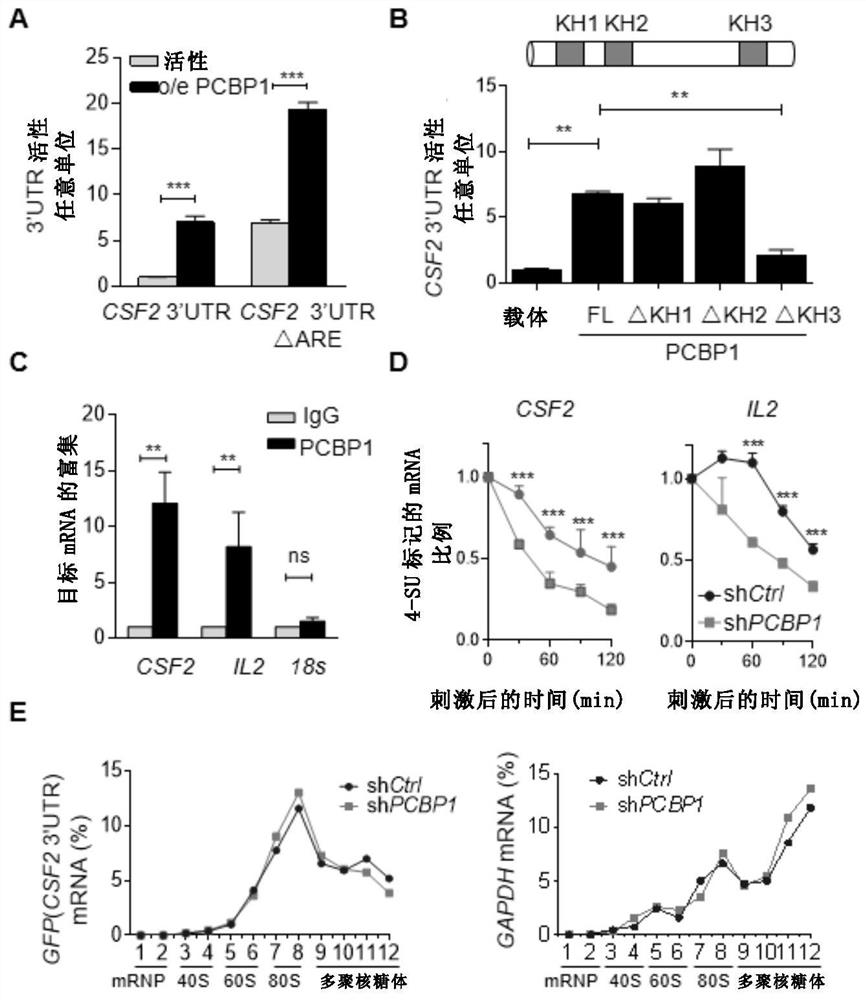Application of pcbp1 gene or its protein regulator in immune system diseases
A use and inhibitor technology, applied in allergic diseases, medical preparations containing active ingredients, anti-inflammatory agents, etc., can solve the problems of expensive, non-targeted pro-inflammatory cytokines, etc.
- Summary
- Abstract
- Description
- Claims
- Application Information
AI Technical Summary
Problems solved by technology
Method used
Image
Examples
Embodiment 1
[0114] Example 1 Screening of autoimmune disease-related factors
[0115]Using a variety of mouse autoimmune models, it was found that GM-CSF produced in CD4+ T cells is the main pathogenic factor of autoimmune diseases, experimental autoimmune encephalomyelitis models (EAE), arthritis models such as CIA or SKG-arthritis model, interstitial lung disease (SKG-ILD) model in SKG mice, etc. Among the subtypes of CD4+ T cells, Th1, Th2, and Th17 can all secrete GM-CSF. Some studies believe that there is a type of CD4+ T cells that only secrete GM-CSF without simultaneously expressing IFNγ or IL17a, named ThGM .
[0116] Th1 cells are a CD4+ T cell subtype that mainly expresses IFNγ, and its secretion of GM-CSF has been proved to be necessary for the pathogenesis of EAE; Th17 cells are a CD4+ T cell subtype that mainly expresses IL17, which was first thought to cause inflammation by secreting IL17. and autoimmune diseases, and studies have found that knockout or antibody neutraliz...
Embodiment 2
[0118] Example 2 GM-CSF related gene screening
[0119] Post-transcriptional regulation plays an important role in the expression of GM-CSF, and the stability of GM-CSF mRNA determines the level of its expression. The regulation at the post-transcriptional level must rely on RNA-binding proteins to function. At least 1500 RNA-binding proteins have been found in the human genome, and the expression of many RNA-binding proteins is tissue- and spatiotemporally specific. Through the detection of high-throughput sequencing data (GSE48138), nearly 100 RNA-binding proteins were found to be highly expressed or have a dynamic trend in T lymphocytes, suggesting that they may have functions in T lymphocytes.
Embodiment 3
[0120] Example 3 Screening of lymphocyte-specific RNA binding proteins
[0121] 3.1 Construction of RNA-binding protein library
[0122] According to the results in Example 2, nearly 100 RNA-binding proteins related to lymphocyte development and differentiation were screened out, and an shRNA library was established, of which 80 RNA-binding proteins most closely related to the RNA-binding domain were shown in Table 1. , and designed shRNA for it, a total of about 300 shRNA.
[0123] Table 1: RNA-binding proteins for shRNA screening
[0124]
[0125] 3.2 RNA-binding protein knockdown screen
[0126] In view of the shortcomings of the primary effector T cells, which have a long differentiation time and cannot proliferate in large quantities, Jurkat cells (human peripheral blood leukemia T cells, purchased from the Cell Resource Center, Shanghai Institutes for Biological Sciences, Chinese Academy of Sciences) were selected to establish a screening model.
[0127] (1) Jurkat...
PUM
 Login to View More
Login to View More Abstract
Description
Claims
Application Information
 Login to View More
Login to View More - R&D
- Intellectual Property
- Life Sciences
- Materials
- Tech Scout
- Unparalleled Data Quality
- Higher Quality Content
- 60% Fewer Hallucinations
Browse by: Latest US Patents, China's latest patents, Technical Efficacy Thesaurus, Application Domain, Technology Topic, Popular Technical Reports.
© 2025 PatSnap. All rights reserved.Legal|Privacy policy|Modern Slavery Act Transparency Statement|Sitemap|About US| Contact US: help@patsnap.com



